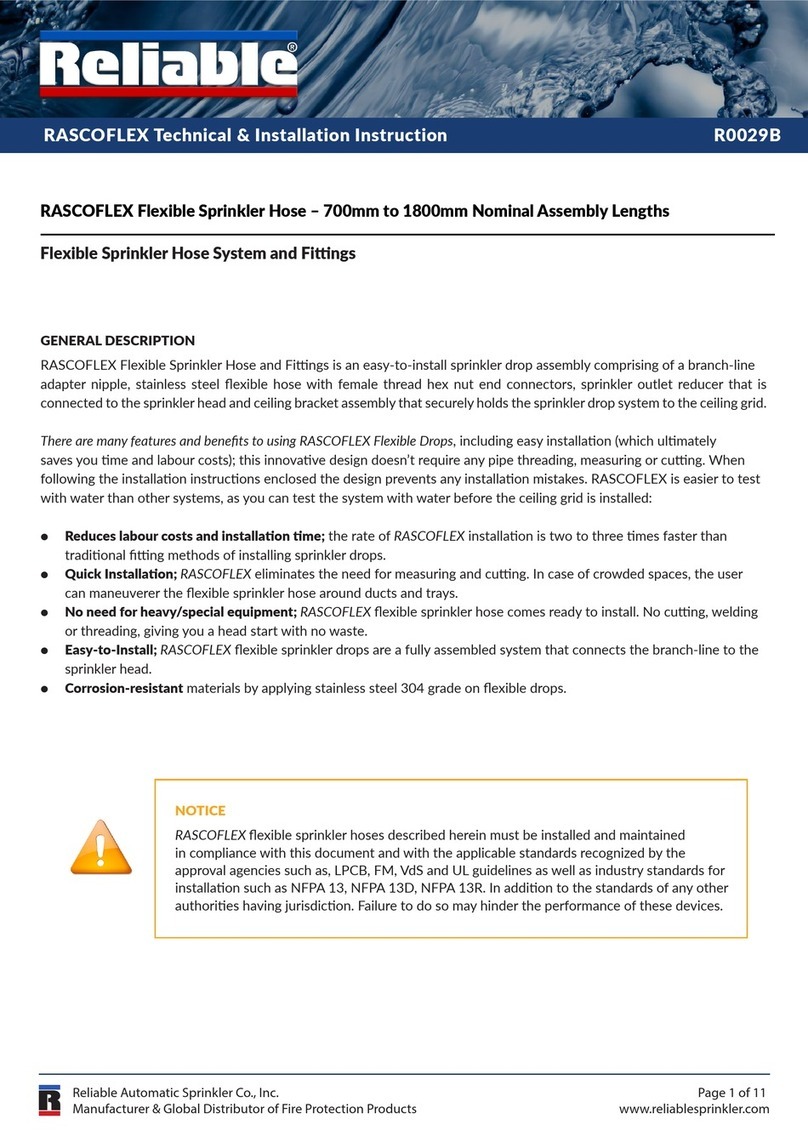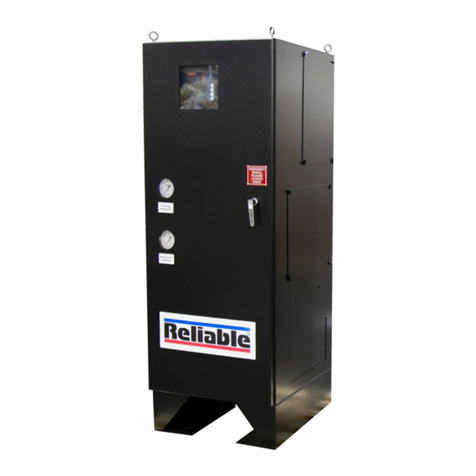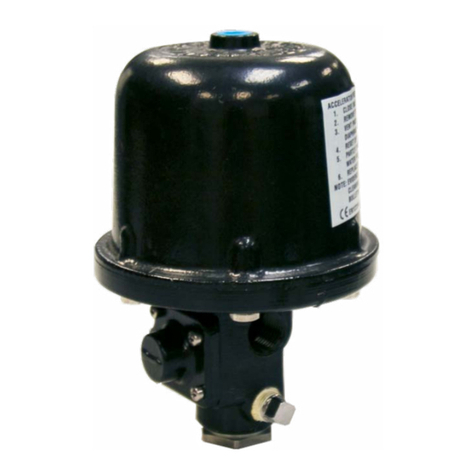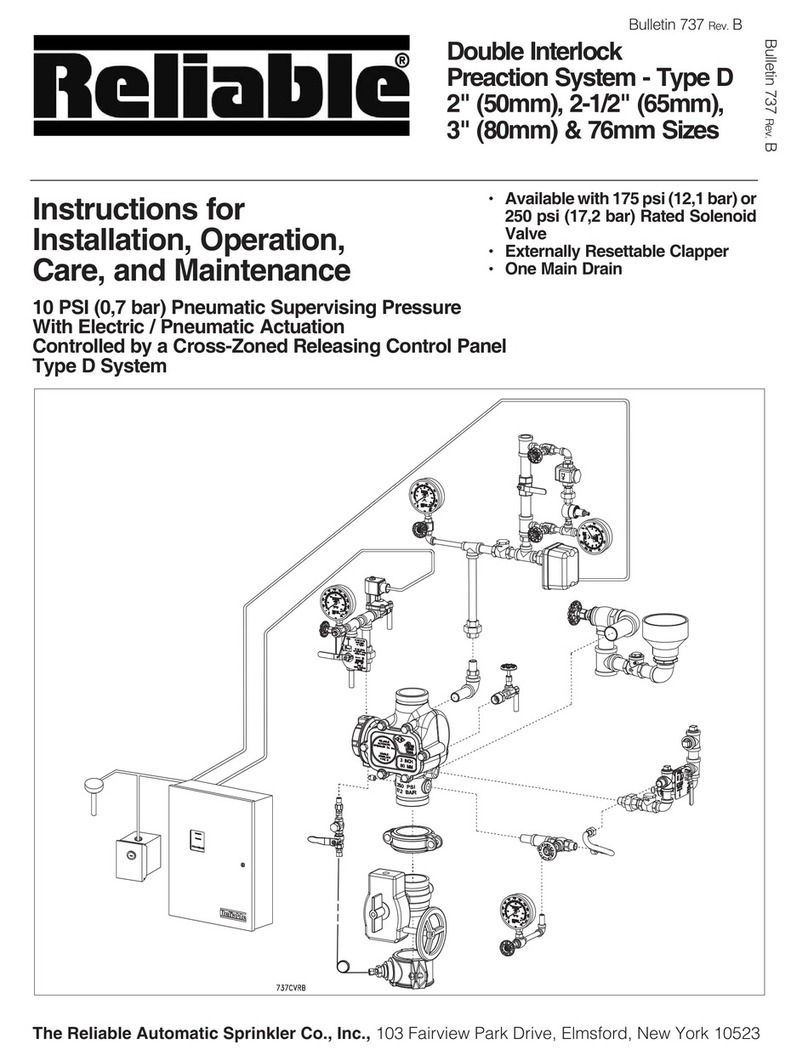Reliable N2-Blast DDX Maintenance manual

Reliable Automatic Sprinkler Co., Inc., 103 Fairview Park Drive, Elmsford, New York 10523
Model DDX N2-Blast®PrePaK™
Type F Preaction System
2” (50mm), 2-1/2” (65mm),
3” (80mm), 4”(100mm)
Bulletin 736 January 2021
Bulletin 736 January 2021
Instructions for
Installation, Operation,
Care and Maintenance
Double Interlock
Electric/Pneumatic Release
General Description
The Reliable Type F Model DDX PrePaK system with inte-
grated nitrogen generation is a completely self-contained, su-
pervised preaction system that can be readily installed within
a floor space of less than 7 ft2(0.65 m2) (not including door
swing). Refer to Fig. 1 for cabinet dimensions. Installation of the
PrePaK system (not including exterior devices, i.e., detectors
and alarm bells), requires just three piping connections. These
connections are the water supply, the sprinkler system and the
drain. Reference locations of these piping connections are
shown in Fig. 1. Independent electrical supplies are required
for the optional system air compressor (115 or 220 VAC), the
optional Potter Model 4410 Releasing Control Panel (115/220
VAC), and the nitrogen generator (115 VAC).
Full assembly drawings for the units are available on the Reli-
able Automatic Sprinkler Company website (www.reliablesprin-
kler.com)
The Reliable Model DDX N2-Blast®PrePaK system incorpo-
rates a South-Tek Systems FPS-900 pressure swing adsorp-
tion N2-Blast®nitrogen generator, complete with independent
air compressor, nitrogen storage tank, and control system. The
nitrogen generator is completely wired, tested, and integrated
with the Model DDX PrePaK system, and supplies 98% pure
nitrogen to the piping network to limit electrochemical, galvanic,
and micro-biologically influenced corrosion (MIC). Operation
and maintenance information can be found in this bulletin as
well as at the South-Tek Systems website (www.southteksys-
tems.com).
The Reliable Type F PrePaK system utilizes an optional Potter
Model PFC-4410-RC Releasing/Control Panel. This fully pro-
grammable, microprocessor-based releasing panel is Under-
writers Laboratories, Inc. Listed and is in compliance with NFPA
13 and NFPA 72. Because the PFC-4410-RC is totally zone
and output programmable, the Reliable Type F PrePaK system
can be utilized in many different preaction applications without
having to rewire any of the factory installed devices. Once the
previously described connections are completed, the 24 VDC
detectors, output devices, and relay contacts may be connect-
ed to achieve the desired system implementation.
8 psi - 24 psi (0.6 bar - 1.7 bar)
System Air/Nitrogen Pressure
Note: N2-Blast®and Blast-off®are registered trademarks of
South-Tek Systems, LLC.

2.
The Type F PrePaK system is designed specically for double
interlock applications. Reliable double interlock preaction sys-
tems are designed for water sensitive areas that require protec-
tion from inadvertent water flow into the sprinkler system piping.
The major benets of a double interlock preaction System,
when compared with a wet pipe system, are as follows:
A. A re alarm sounds prior to the flow of water from a
sprinkler, which may enable extinguishment of the
re by handheld means before the operation of any
sprinkler occurs.
B. An annunciator signals whenever the integrity of pip-
ing or sprinklers is accidentally or intentionally dis-
turbed; however, no water flow occurs at that time.
C. Detection and notication of a re condition are pro-
vided by re detectors, without the delay associated
with water delivery time in the event of a re. Note
that with a wet pipe system, the re alarm is delayed
until after water has begun flowing from and oper-
ated sprinkler.
To flow water into the system piping of a Type F double inter-
lock preaction system, two events must take place:
1) A re detection device must detect heat and/or smoke
thereby causing the releasing/control panel to energize
the normally-closed solenoid valve.
2) The sprinkler system piping must discharge enough
supervisory air for the Model LP Dry Pilot Actuator to
operate. This is generally the result of a sprinkler oper-
ating due to re.
In the event that the system piping is ruptured, or a sprinkler
head is accidentally opened, the Model LP Dry Pilot Actuator
will open and a low system air pressure alarm will sound. The
Model DDX Deluge Valve, however, will not be released to flow
water since the solenoid valve still remains closed. Conversely,
in the event of a false detection signal, the releasing/control
panel will activate an alarm, but the Model DDX Deluge Valve
will not flow water due to the fact that the Model LP Dry Pilot
Actuator remains closed.
When using the Reliable Type F PrePaK system in double
interlock applications the sprinkler system is pressurized (su-
pervised) with air provided by the optional factory-installed air
compressor (or on-site Nitrogen supply) and is monitored by
a system pressure switch. If Nitrogen is used as the supervi-
sory gas, an optional Nitrogen Kit is available. This kit contains
a regulator and an additional pressure switch that is used to
monitor any low pressure conditions that may arise due to hav-
ing a limited Nitrogen supply. The optional factory-installed air
compressor can be utilized for make-up air until the Nitrogen
supply can be replenished.
Note: Compressed air is not to be considered as dry air and
may create ice plugs in the sprinkler system piping.
A Model B Hydraulic Manual Emergency Releasing station is
standard equipment in the Type F PrePaK system. It consists of
an aluminum nameplate mechanically attached to a ball valve.
The valve handle in its OFF position is guarded against acci-
dental turning to the ON position (and system discharge) by a
nylon cable tie provided with the PrePaK system assembly. The
cable tie is designed to allow, in case of an emergency, forceful
turning of the valve handle to the ON position.
Approvals
• The Model DDX N2-Blast PrePaK Type F preaction system is
FM Approved as a factory-assembled Preaction System to
Approval Standard 1011/1012/1013, Deluge and Preaction
Sprinkler Systems.
• The Model DDX deluge valve and Type F preaction trim are
FM Approved and cULus Listed.
• The South-Tek N2-Blast® Model FPS-900-RS nitrogen gen-
erator is FM Approved to Approval Standard 1035, Nitrogen
Generators for Corrosion Mitigation.
Technical Data
1. The Reliable Model DDX Type F PrePaK system is rat-
ed for a minimum water supply pressure of 20 psi (1.4
bar). When tted with the optional 300 psi (20.7 bar)
solenoid, the 2”, 2-1/2”, 3”, and 8” sizes are rated for
a maximum pressure of 250 psi (17.2 bar), and the 4”
and 6” sizes are rated for a maximum pressure of 300
psi (20.7 bar). Water temperature must be maintained
between 40°F and 140°F (4°C and 60°C).
2. Friction loss, expressed in equivalent length of Sched-
ule 40 pipe and based on Hazen-Williams Formula is:
System Size: Equivalent Length
2” (50mm) 19.4 ft (1.3 m)
2½” (65mm) 24.5 ft (1.8 m)
3” (80mm) 28.9 ft (3.8 m)
4” (100 mm) 32.8 ft (17.7 m)
These values account for the Model DDX Deluge Valve,
supply manifold tee, butterfly control valve, and small pipe/
manifold located directly above Model DDX Deluge Valve.
3. Shipping Weight:
System Size Weight
2” (50mm)
950 lbs (431 kg)2-1/2” (65mm)
3” (80mm)
4” (100 mm) 1075 lbs (488 kg)
4. Please reference Figure 1 for dimensions.
The following is a list of Technical Data Bulletins which de-
scribe the valves and devices which are used in the system:
Device Reliable Bulletin #
(unless otherwise noted)
Model DDX Deluge Valve Reliable Bulletin 519
Type F Double Interlock Preaction Trim Reliable Bulletin 751
Low Air Pressure Switch Potter, 5401564
Alarm Pressure switch Potter, 5400928
Releasing Control Panel Potter Manual #5403550
The following table provides a quick reference to the various
programs (found in this bulletin and the Potter Manual
#5403550) that may be utilized with a Type F PrePaK system:
Desired Application Program
Single Interlock,
Single Zone
Potter Program #6
(Factory Setting)
Single Interlock,
Cross-Zoned Potter Program #7
Note: The Model DDX Type F PrePaK Double Interlock Preaction
system utilizes a solenoid controlled by single interlock programming
in conjunction with a pneumatic (mechanical) actuator.

3.
Fig. 1

4.
System Air / Nitrogen Pressure Requirements
The Model DDX Type F PrePaK system includes gauges indi-
cating the pneumatic and water pressures of Model LP Dry Pilot
Actuator. Table A species the air or nitrogen pressure level to be
applied to the Actuator. The factory installed Pressure Mainte-
nance Device in the unit automatically provides adequate makeup
air or nitrogen flow to maintain supervisory pressure with normal
leakage for the system piping, while restricting the flow of makeup
air or nitrogen to allow for system operation. Please note that
when the optional Model B1 Accelerator is to be utilized to expe-
dite water-delivery time, the pneumatic pressure must be not less
than 15 psi (1.0 bar).
Table A
When the air compressor in the Model DDX Type F PrePaK
system is used to initially ll the sprinkler system with air, the steel
enclosure door should remain open to provide maximum intake
air flow to the air compressor. The air compressor is connected
to a storage tank. This tank functions as a reservoir, providing
make-up air to compensate for small, intermittent leaks in the
sprinkler system. It should be noted that signicant leaks may
overburden this storage tank, thereby causing the air compres-
sor to continuously cycle on and off.
The factory-installed system air pressure switch may need
on-site adjustment to correspond with the air pressure values
found in Table A. Adjustment, if required, should be made ac-
cording to Potter Bulletin 5401564 included with the switch.
Installation Requirements
The automatic sprinklers, releasing devices, re detec-
tion devices, manual pull stations, and signaling devices
which are utilized with the Reliable Model DDX Type F
PrePaK system must be UL and/or ULC Listed or FM Ap-
proved, as applicable.
The steel enclosure and all the interconnecting piping
must be located indoors in a readily visible and acces-
sible location and in an area that can be maintained at a
minimum temperature of 40°F (4°C). Note: Heat tracing is
not permitted. The solenoid valve is operated and super-
vised by the Potter Model PFC-4410-RC Releasing Control
Panel. Details on the electrical connections of this system
to the Potter Panel can be found in the Potter Manual
#5403550, Installation, Operation and Instruction of PFC-
4410-RC Releasing Control Panel (this manual is included
with other pertinent manuals and shipped inside the en-
closure). This panel is fully zone and output programmable
and may be adapted to several applications. Hydrostatic
Testing of DDX Valves and DDX Systems.
Optional Seismic Kit
Reliable part number 6501200041 (25” x 28” cabinet for 2”
-4” systems without nitrogen generator) and 6501200042 (30”
x 33” cabinet for 6” and 8” systems, and all units with nitrogen
generator) are seismic upgrade kits required to make the Re-
liable PrePaK OSHPD compliant. One kit is required for each
PrePaK (reference Caution Sheet 331).
Hydrostatic Testing of DDX Valves and DDX
Systems
As required by NFPA 13, re sprinkler systems with working
pressures up to and including 150 psi are to be hydrostatically
tested at a water pressure of 200 psi. Fire sprinkler systems with
working pressures above 150 psi are required to be hydrostati-
cally tested at 50 psi above the system working pressure. In addi-
tion to the hydrostatic tests described above, dry pipe and double
interlock preaction systems require an additional low pressure air
test.
In some cases, hydrostatic testing (in accordance with the NFPA
13 requirements noted above) will result in pressures that exceed
the working pressure of the valve and trim kit for the two-hour test
period. The valve and applicable trim kit have been tested, ap-
proved and listed under these conditions and as such, hydrostatic
testing in accordance with NFPA 13 is acceptable. In addition, the
clapper can remain in the closed position and the trim kit need not
be isolated, as each has been designed to withstand hydrostatic
testing as required by NFPA 13.
Hydrostatically testing the valve and trim to pressures higher
than their rating is limited to the hydrostatic test as referenced by
NFPA13. It does not address the occurrence(s) of a “water ham-
mer” effect, which can indeed damage the valve. A “water ham-
mer” in the water supply piping of the valve can create pressures
in excess of the rated pressure and should be avoided by all nec-
essary means. This condition may be created from improper re
pump settings, underground construction work, or an improper
venting of trapped air in the water supply piping.
Water Pressure psi (bar) System Air or Nitrogen Pressure
psi (bar)
Maximum Not Less Than
20 (1.4) 8 (0.6)
30 (2.1) 10 (0.7)
50 (3.4) 12 (.8)
75 (5.2) 13 (.9)
100 (6.9) 15 (1.)
125 (8.6) 16 (1.1)
150 (10.3) 17 (1.2)
175 (12.1) 18 (1.2)
200 (13.8) 19 (1.3)
225 (15.5) 21 (1.4)
250 (17.2) 22 (1.5)
275 (19.0) 23 (1.6)
300 (20.7) 24 (1.7)
Notes:
1. Supervisory air or nitrogen pressure should not exceed 30 psi (2.1 bar).
Excess pressure may result in damage to the actuator.
2. Fastest valve operation is achieved with supervisory air or nitrogen
pressure indicated; however, pressure must never be less than the
minimum specied in the table above.
3. Air maintenance devices that maintain a constant pressure are
recommended; however, if a tank-less compressor is used, the
“compressor on” setting of the pressure switch must never be lower than
the minimum pressure in the table above.

5.
be vented to drain through its outlet. Since the push-rod cham-
ber pressure cannot be replenished through the inlet restriction
as rapidly as it is vented, the pressure falls rapidly. When the
push-rod chamber pressure drops below one-third of the wa-
ter supply pressure, the force acting beneath the valve clapper
becomes greater than the push-rod force acting on the lever
which causes the clapper to open. Refer to Reliable Technical
Bulletin 751 for further details.
Once the clapper has opened, the lever acts as a latch, pre-
venting the clapper from returning to the closed position. Water
from the supply flows through the deluge valve into the system
piping and also through the alarm outlet to activate water flow
alarm devices. Note that the solenoid valve will be maintained
open by the Potter Model PFC-4410-RC Releasing/Control
Panel latching feature until it is reset for operation.
After system shutdown and draining, the Model DDX Deluge
Valve clapper is easily reset without special tools using the ex-
ternal reset feature. Restore detection devices by resetting or
replacing any operated device. Once detection devices are re-
stored the system can be reset (see Resetting Model DDX Type
F Double Interlock Preaction System).
Resetting Model DDX Type F Double Interlock
Preaction System
1. Close the valve controlling water supply to the Deluge
Valve and close the air or nitrogen supply to the sprinkler
system.
2. Close the pushrod chamber supply valve.
3. Open main drain valve and drain system.
4. Open all drain valves and vents at low points throughout
the system, closing them when flow of water has stopped.
Open the Model B Manual Emergency Station to relieve
pressure in the pushrod chamber of the Deluge Valve.
5. With the alarm line valve open, push in the plunger of
ball drip valve, forcing the ball from its seat, and drain the
alarm line.
6. With the Model B Manual Emergency Station open,
push in and rotate the Deluge Valve’s external reset knob
counterclockwise (when facing the valve), until you hear a
distinct noise indicating that the clapper has reset. Note:
The reset knob can be rotated only while pressure in the
pushrod chamber is vented to atmospheric conditions (0
psig).
7. Inspect and replace any portion of the detection system
and/or sprinkler system subjected to re conditions.
8. Open the pushrod chamber supply valve and allow wa-
ter to ll the pushrod chamber. Close the Model B Manual
Emergency Station.
9. Purge all air from the actuation piping: Open the so-
lenoid valve by operating a detector or an electric manual
emergency station. Note that the Model LP Dry Pilot Actua-
tor should also be open since there is no pneumatic pres-
sure on the system.
10. While water is flowing through the solenoid valve AND
the actuator, cause the actuator to close rst by applying air
or nitrogen pressure to the system.
System Electrical Requirements
All releasing, alarm, and detection devices in the Reliable
Model DDX Type F PrePaK system are supervised by a Potter
Model PFC-4410-RC Releasing Control Panel. All of the termi-
nals are translated to a water-tight terminal box mounted on
the interior of the enclosure. All eld wiring is connected to this
terminal box. Note: The EOL (End of Line) resistors have also
been relocated.
The Reliable Model DDX PrePaK system is delivered with
six factory-installed electrical devices. They consist of the fol-
lowing:
1. A system air pressure switch, which is used to monitor
sprinkler piping.
2. An alarm pressure switch, which indicates an actuation of
the deluge valve.
3. A normally-closed, releasing solenoid valve, which is used
to actuate the deluge valve.
4. A 1/2 HP (2”, 2-1/2”, & 3” valve) or 1 HP (4” valve) air
compressor with tank.
5. A supervised butterfly (main control) valve (Note: A system
side butterfly valve is available as an option).
6. A release control disable switch (RCDS) which is used to
disable the solenoid valve for test purposes.
The factory electrical connections of these devices, along
with information on the connection of detection devices (initiat-
ing zones 1 and 2), signaling devices, and supervisory outputs
to the Potter PFC4410-RC Releasing Control Panel are includ-
ed in this bulletin. The power supply, standby emergency power
supply, battery charger and rectier circuitry are all contained
within the PFC4410 panel. Batteries that provide 90 hours of
standby power are provided with the panel. For additional in-
formation and detailed wiring diagrams, please refer to Potter
Manual #5403550 (Installation, Operation and Instruction of
PFC4410-RC Releasing Control Panel).
Note: In order for the solenoid valve to maintain a warranty it must
remain sealed as it came from the factory. If there are concerns
about the valve’s internal components, immediate replacement is
recommended.
System Operation (Double Interlock)
To fully activate (discharge water from) the Reliable Model
DDX Type F PrePaK system, a re detection device must ac-
tivate and pneumatic pressure must be lost from the sprinkler
system piping (normally from the activation of one or more re
sprinklers).
When the system is properly set for service, the water sup-
ply pressure simultaneously acts on both the underside of the
deluge valve’s clapper and on the valve’s push rod by means
of the pressurized push rod chamber. The resultant pressure
force acting on the push rod, in unison with the mechanical
advantage of the deluge valve lever, is more than sufcient to
hold the valve clapper in the closed position against the water
supply pressure.
Energizing the releasing solenoid valve is only one of the
events required towards opening the deluge valve. Air pres-
sure in the sprinkler system must also be reduced to a level
low enough to activate the Model LP Dry Pilot Actuator. Both
of these events allows the deluge valve’s push-rod chamber to

6.
11. Open the air or nitrogen supply quick ll valve to restore
supervisory pressure in the sprinkler system and close the
dry pilot actuator. Allow the pressure to build to the level
specied in Table A, then set the pneumatic supply to au-
tomatic operation. (Note: To build supervisory air pressure
in the sprinkler system, it may be necessary to temporarily
close the main drain valve and the alarm line valve until air
pressure has built up to the recommended level.)
12. After the Model LP Dry Pilot Actuator has been set,
close the solenoid valve by resetting the release control
panel. (All detectors and manual pull stations must be in a
normal state before the panel can be reset.)
Note: It is important that the piping between the solenoid
valve and the dry pilot actuator is lled with water and not
air. This is accomplished by closing the dry pilot actuator
FIRST while water is flowing through the device and closing
the solenoid valve only AFTER the actuator is completely
set.
13. Open the alarm line valve. Verify the main drain valve
is open. Slightly open the main valve controlling water sup-
ply to the Model DDX Deluge Valve, closing the main drain
valve when water flows. Observe if water leaks through the
ball drip valve. If no leak occurs, the Deluge Valve clapper is
sealed. Slowly open the main valve controlling water supply
until fully open and verify that it is properly monitored.
14. Verify that the pushrod chamber supply valve and alarm
line valve are open. The pushrod chamber supply valve
must remain open when the Deluge Valve has been reset,
to maintain water pressure in the pushrod chamber.
15. Verify that the Model B Manual Emergency Station is
secured in the OFF position with the appropriate nylon tie.
Inspection and Testing
1. Water supply — Conrm that valves controlling water
supply to the Deluge Valve are opened fully and properly
monitored.
2. Alarm line — Conrm that the alarm line valve is open
and remains in this position.
3. Other trim valves — Conrm that the pushrod chamber
supply valve is open, as well as all pressure gauge valves.
The main drain valve, condensate drain valve, and alarm
test valve should be closed.
4. Ball drip valve — Push in on the plunger to be sure ball
check is off its seat. If no water appears, the Deluge Valve
water seat is tight. Inspect the bleed hole on the underside
of the pushrod chamber for leakage.
5. Dry pilot trim — Inspect air pressure for conformance to
Table A.
6. Releasing device — Check outlet of the releasing de-
vice (i.e., solenoid valve and hydraulic manual emergency
station) for leakage. Also verify that tubing drain lines from
releasing devices are not pinched or crushed which could
prevent proper releasing of the Deluge Valve.
7. Testing alarms — Open the alarm test valve permitting
water from the supply to flow to the electric sprinkler alarm
switch and to the mechanical sprinkler alarm (water motor).
After testing, close this valve securely. Push in on the plung-
er of ball drip valve until all water has drained from the alarm
line.
8. Operational test — Open the Model B Manual Emer-
gency Station. Alternatively, operate the electrical detection
system and deplete pneumatic pressure from the sprinkler
system.
Note: AN OPERATIONAL TEST WILL CAUSE THE DEL-
UGE VALVE TO OPEN AND FLOW WATER INTO THE
SPRINKLER SYSTEM.
9. Secure the Model B Manual Emergency Station in the
OFF position with nylon tie after Deluge Valve is reset.
Testing Detection System Without Operating
Deluge Valve
1. Close the valve controlling water supply to the deluge
valve and open the main drain valve.
2. Verify that valve supplying hydraulic pressure to the pis-
ton/pushrod chamber is open, allowing water to enter the
pushrod chamber.
3. Operate the electrical detection system and deplete
pneumatic pressure from the sprinkler system.
4. Operation of the detection combined with loss of pneu-
matic pressure must result in a sudden drop of water pres-
sure in the pushrod chamber, as indicated by the pressure
gauge on the hydraulic release trim.
5. Reset the valve per the reset instructions.
Maintenance
The owner is responsible for maintaining the re protection
system in proper operating condition. Any system main-
tenance or testing that involves placing a control valve or
detection/control system out of service may eliminate the
re protection that is provided by the re protection system.
The Reliable Model DDX valve and associated equipment
shall periodically be given a thorough inspection and test.
NFPA 25, “Inspection, Testing, and Maintenance of Water
Based Fire Protection Systems,” provides minimum mainte-
nance requirements. System components shall be tested,
operated, cleaned, and inspected at least annually, and
parts replaced as required. Replace any components found
to be corroded, damaged, worn, or non-operable. Increase
the frequency of inspections when the valve is exposed to
corrosive conditions or chemicals that could impact materi-
als or operation of the assembly.
If face plate is removed during maintenance, torque face
plate bolts to the following values during re-installation:
35 ft-lbs. (47 N-m) for 2” through 4” valves
70 ft-lbs. (95 N-m) for 6”-8” valves

7.
Draining Excess/Condensate Water from the
System
1. Notify the owner and monitoring company that mainte-
nance is being performed on the system.
2. Close the main water control valve.
3. Open the Main Drain Valve.
4. Open the Condensate Drain Valve until all water has
drained.
5. Close Condensate Drain Valve.
6. Partially open the Main Water Control Valve.
7. Slowly close the Main Drain Valve.
8. Fully open the Main Water Control Valve.
9. Notify the owner and monitoring company that the sys-
tem has been returned to service.
SOLENOID VALVE INSPECTIONS, TESTS
AND MAINTENANCE
WARNING: THE OWNER IS RESPONSIBLE FOR MAIN-
TAINING THE FIRE PROTECTION SYSTEM IN PROPER
OPERATING CONDITION. ANY SYSTEM MAINTE-
NANCE OR TESTING THAT INVOLVES PLACING A
CONTROL VALVE OR DETECTION SYSTEM OUT OF
SERVICE MAY ELIMINATE THE FIRE PROTECTION
OF THAT SYSTEM. PRIOR TO PROCEEDING, NOTIFY
ALL AUTHORITIES HAVING JURISDICTION. CONSID-
ERATION SHOULD BE GIVEN TO EMPLOYMENT OF A
FIRE PATROL IN THE AFFECTED AREA.
WARNING: PRIOR TO OPERATING THE SOLENOID
VALVE, BE SURE TO CLOSE THE SYSTEM CONTROL
VALVE TO AVOID UNINTENTIONAL OPERATION OF
THE DELUGE VALVE
1. Inspections: It is imperative that the system be inspect-
ed and tested in accordance with NFPA 25 on a regular
basis. The frequency of the inspections may vary due to
contaminated water supplies, corrosive water supplies,
or corrosive atmospheres. In addition, the alarm de-
vices, detection systems, or other connected trim may
require a more frequent schedule. Refer to the system
description and applicable codes for minimum require-
ments.
2. The valve must be inspected at least monthly for cracks,
corrosion, leakage, etc., cleaned and replaced as nec-
essary.
3. If leakage is suspected through the solenoid valve, it
should be replaced.

8.
Fig. 2
Note: Trim valve location is common to wet pilot line,
dry pilot line, and electric release systems.

9.
Fig. 3

10.
Fig. 4

11.
Fig. 5

12.
Fig. 6

13.
Fig. 7

14.
Fig. 8 — Wiring Diagram

15.
Fig. 9 — Wiring Diagram

16.
POTTER PROGRAM #6
OUTPUTS
ZONES
Supervisory 2 (1)
#1
Conventional (2)
#2
Conventional(2)
#3
Waterflow
#4
Low Air Supervisory
#1 ALARM X
#2 WATERFLOW X
#3 SUPERVISORY X X
#4 RELEASE X
Single Interlock, Single Detection Zone
Potter Program #6
1. Apply power to panel.
2. Slide the program switch down.
3. Press the FUNCTION button until the display reads
“PASSWORD=000.”
4. To enter a password, press the SELECT button until the
proper number is displayed above the “^” symbol; then
press the SET button to move to the next digit. After
entering the third number the display will change. (All
panels are shipped with a “000” password.)
5. Press the FUNCTION button until the display reads
“PROGRAM ##.” (the second “#” character refers to
the current program number between “0” and “24”).
6. Press the SELECT button until the display reads “PRO-
GRAM #6.”
7. Press the SET button
8. The panel is completely programmed except for the
custom banner and zone messages. Slide the program
switch back up.
INPUTS: 1 conventional zone, 1 manual release
zone, 1 waterflow zone, 1 low air zone, 1 supervisory zone.
OUTPUTS: 1 general alarm bell, 1 waterflow bell, 1 supervisory bell, 1 solenoid release circuit.
OPERATION: Activation of either conventional zone (or operation of the manual pull station within the PrePaK system
cabinet) will operate the solenoid release circuit and the general alarm bell. Activation of the waterflow zone
will operate the waterflow bell. Activation of either the low air zone or the supervisory zone will operate the
supervisory bell. When either Zone #1 or #2 is in alarm, Output #1 (general alarm) and Output #4 (solenoid
release) will operate. When Zone #3 is in alarm, Output #2 (waterflow bell) will operate. When either Zone
#4 or the supervisory zone is activated, Output #3 (supervisory bell) will operate.
Note:
(1) The Butterfly valve in the PrePaK system assembly is connected to Supervisory 2 input of the Potter PFC-4410RC Re-
leasing/Control panel
(2) The emergency manual release within the PrePaK system cabinet is wired into the conventional detection zones 1 and 2, and is de-
signed to release the solenoid for setup and testing purposes.
For additional Information, please refer to the “Installation, Operation, and Instruction Manual” for the Potter
PFC4410-RC Releasing Control Panel (provided with the unit).

Single Interlock, Cross Zoned Detection
Potter Program #7
1. Apply power to panel.
2. Slide the program switch down.
3. Press the FUNCTION button until the display reads
“PASSWORD = 000.”
4. To enter a password, press the SELECT button until the
proper number is displayed above the “^” symbol; then
press the SET button to move to the next digit. After
entering the third number the display will change. (All
panels are shipped with a “000” password).
5. Press the FUNCTION button until the display reads
“PROGRAM ##.” (the second “#” character refers to
the current program number between “0” and “24”).
6. Press the SELECT button until the display reads “PRO-
GRAM #7.”
7. Press the SET button.
8. The panel is completely programmed except for the
custom banner and zone messages. Slide the program
switch back up.
INPUTS: 2 conventional zones (cross-zoned), 1 wa-
terflow zone, 1 low air zone, 1 supervisory zone.
OUTPUTS: 1 general alarm bell, 1 waterflow bell, 1 supervisory bell, 1 solenoid release circuit.
OPERATION: Activation of both conventional zones at the same time (or operation of the manual pull station within the
PrePaK system cabinet) will operate the solenoid release circuit and the general alarm bell. Activation of
either conventional zone will operate the general alarm bell. Activation of the waterflow zone will operate the
waterflow bell. Activation of either the low air zone or the supervisory zone will operate the supervisory bell.
When either Zone #1 or #2 is in alarm, Output #1 (general alarm) will operate. When Zones #1 and #2 are
in alarm at the same time, Output #4 (solenoid release) and Output #1(general alarm) will operate. When
Zone #3 is in alarm, Output #2 (waterflow bell) will operate. When either Zone #4 or the supervisory zone
is activated, Output #3 (supervisory bell) will operate.
Note:
(1) The Butterfly valve in the PrePaK system assembly is connected to Supervisory 2 input of the Potter PFC-4410RC Re-
leasing/Control panel
(2) The emergency manual release within the PrePaK system cabinet is wired into the conventional detection zones 1 and 2, and is de-
signed to release the solenoid for setup and testing purposes.
For additional Information, please refer to the “Installation, Operation, and Instruction Manual” for the Potter
PFC4410-RC Releasing Control Panel (provided with the unit).
POTTER PROGRAM #7
OUTPUTS
ZONES
Supervisory 2 (1)
#1
Conventional (2)
#2
Conventional(2)
#3
Waterflow
#4
Low Air Supervisory
#1 ALARM X X
#2 WATERFLOW X
#3 SUPERVISORY X X
#4 RELEASE XX XX
17.

FPS-900-RS Nitrogen Generator
General
This manual provides instruction for the proper use and
maintenance of South-Tek Systems N2-Blast®FPS-900-RS.
South-Tek Systems and Reliable are not responsible for dam-
ages when using this in manners not approved by South-Tek
Systems and Reliable. The user(s) of this document should
confer any questions with a qualied South-Tek Systems
representative on its commissioning and correct use. Please
contact South-Tek Systems with any question or concerns at:
South-Tek Systems, LLC
2940 Orville Wright Way Ste 600
Wilmington, NC, 28405
Tel: (888) 526-6284
Email: Info@southteksystems.com
http://www.southteksystems.com/
Important Information
All personnel (and their supervisors) installing, operating, and
maintaining the N2-Blast®must read and fully understand
this manual prior to installing, operating or performing main-
tenance. The N2-Blast®produces nitrogen (N2) at a low flow
rate, which quickly dissipates into the air. N2 gas is not poison-
ous, but do not directly inhale since high concentrations can
cause asphyxiation. Install the unit in a well-ventilated room
that is not sealed off from normal living space air changes. All
personnel involved with the installation, operations, and main-
tenance of the N2-Blast®must follow safe working practices,
including OHSA and local health/safety code regulations.
Safety Guidelines
The following section outlines the basic safety consider-
ations about installation and operation of the N2-Blast®FPS-
900-RS. For other equipment used with the nitrogen genera-
tor, such as external air compressors, and dryers, refer to the
manufacturer’s safety guidelines.
Using the N2-Blast®FPS-900-RS correctly is important
for safety and trouble-free operation. Wrong use can cause
damages to the system or can lead to incorrect gas supply.
The nitrogen generator produces nitrogen at a low flow rate,
which quickly dissipates into the air. Nitrogen is not poison-
ous, but do not directly inhaled, since high concentrations,
can cause asphyxiation. Install the unit in a well-ventilated
room, unsealed off from normal living space air changes.
Warning: Install the unit in a within a well-ventilated room,
one that is not sealed off from normal living space air changes.
Read carefully and act accordingly before operating or
repairing the unit:
• The operator must use safe working practices and rules
when running the nitrogen generator.
• The owner is responsible for always keeping the unit in
safe working conditions.
• Always use approved parts when performing mainte-
nance and repairs. Make sure that replacement parts
meet or exceed the original parts’ specication.
• Only competent individuals, trained and authorized, can
install, operate, perform maintenance and repair.
• Isolate incoming and outgoing pressures to the genera-
tor, and depressurize the service or repair section before
performing any mechanical work, including changing the
lters.
• Vent the nitrogen generator’s exhaust gas outside or to
a large, well-ventilated room to avoid suffocation due to
lack of oxygen.
• Wear safety glasses if the cabinet door is open while the
machine is running.
• Use ear protection when the equipment is running.
NOTE: Always following local and site safety regula-
tions in conjunction with this manual. Correct use of
the nitrogen generator is important for personal safety.
Incorrect safety practices can cause damage to the in-
dividual and equipment.
Follow safe working practices, OSHA, and local health and
safety regulation when maintaining the N2-Blast® FPS-900-
RS.
Air Supply
The N2-Blast®FPS-900-RS includes a built-in air com-
pressor to supply gas to the nitrogen generator. It is not for
performing quick lls; a separate suitable air compressor
should be used to ll the system.
Electrical Requirements
The N2-Blast®FPS-900-RS requires 120VAC / 50-60hz
/ 1ph and draws < 8A. A 240VAC option is also available. It
has a built-in 20A over-current protection device and comes
with a standard 3-prong US power cord for the electrical con-
nection (unless otherwise specied). It comes with UL 508A
ICP certication, and the electrical schematics are available
upon request.
Site Specications
Unless designed otherwise, install in a nonhazardous
indoor location with temperatures between 40-100°F (4°-
38°C). For ease of maintenance, troubleshooting, and mini-
mizing pressure drop, install the equipment in the same area.
Leave enough space around the generator and other equip-
ment for routine maintenance.
18.

Key Features
Air Compressor
An oil-less internal air compressor has an engineered
dampening system reducing vibration and noise throughout
the cabinet. The air compressor has a pre-lter to catch small
particulates that can cause damage. The recommended
replacement for the pre-lter is 1000 run hours or 1-year,
whichever comes rst. Dirtier environments may need more
frequent changes. Consult with the supplier for a different l-
ter maintenance schedule if installing in a dirty environment.
Air Filters
The generator has an air inlet pre-lters and two lters
between the compressed air and O2separation beds - the
particulate and coalescing. The 5-micron particulate lter
catches the bulk particles, and the 0.1 micron coalescing
catches the remaining smaller particles. Both lters feature
an auto-drain that drains any water buildup within the lter
housing. These drain lines are on the cabinet’s bottom right
side. Connect these drain lines to a safe location.
Programmable Logic Controller
An integrated PLC within the cabinet that features smart
timing to maximize the generator’s performance. It controls
the valve timing and sequencing to move compressed gas
throughout the system. It also has a smart feature to auto-
matically switch between different “modes” based on the cur-
rent run stages (see Chapter 7: System Operation for more
about the unit’s functionality).
Safety Relief Valves
The installed ASME safety relief valves add additional
safety to protect component failures.
Nitrogen Tank
A nitrogen tank inside the cabinet comes with ball valves,
safety relief, and a gauge.
Automatic Cut-In and Cut-Out
The generator starts and stops based on a pressure
switch. Do not adjust the factory preset cut-in and out pres-
sure without rst consulting with South-Tek Systems.
Patented BlastOff®– Leak Detection System
The “BlastOff® Leak Detection” is a patented feature
which sends an alarm if it detects a possible gas leak. The
alarm signal can be an audible, visual, and dry contact con-
nection to the “Building Management System (BMS)”. Power
cycle the unit to reset the alarm but avoid doing this without
nding the cause, as it will shorten the generator’s life.
N2-Blast® FPS-900-RS Specications
• Nitrogen Purity 98.5+%
• Integrated Installation in Reliable PrePaK system
• Display Hours/Power on/Operating
• N2Storage Pressure 60-70 PSIG (±5%)
• Cabinet Port Connections 1/2” NPT Female
• Electrical 110-220V / 50-60Hz / 1Phase; 20 Amp Break-
er
• Compressor Integral / Oil-Free
• Ambient Temperature 40° to 100°F
• Noise Level (dbA) < 90 dbA
Operation
The nitrogen generator uses valve sequencing to pro-
duce nitrogen. The design meets specications of a re
protection system. Consult with South-Tek System for writ-
ten approval before performing any eld changes or custom-
ization. Unauthorized changes void all warranties and may
cause damages or malfunctions to the system.
This section describes the major control functions and
instrumentations associated with the nitrogen generators.
All programs are proprietary and password protected from
the factory. Do not alter any controls or instrumentations.
Changes without South-Tek Systems’ written consent voids
the performance specications.
Controller Modes
To utilize the buttons on the front of the controller the unit
must be in “S” or “Switch” mode and unlocked. If the sys-
tem is displaying “LOCK”, the Mode Select Button may be
pressed and held to unlock the controller (repeat this step if a
system lockout is desired). To change to Switch Mode, press
the Mode Select Button when the controller is unlocked until
the System Mode Indicator displays “S”. This mode allows
access to two features:
• Alarm Simulation (5) – Hold the Alarm Simulation Button
for 3 seconds or press the lter replacement reset but-
ton 3 times within 3 seconds to activate. This will simu-
late an alarm condition and trip the alarm dry contact in
the unit for 2 seconds so that proper functioning can be
conrmed.
• Filter Change Reset (0) – When a new FRP (Filter Re-
placement Kit) is installed, the 1000- hour lter change
time must be reset. After replacing the lter elements,
press and hold the Filter Change Reset Button for 7 sec-
onds. An audible beep will conrm that the time is reset
and lter alarm will be reset. (Note: this will also trigger
the Customer Alarm Relay for one second)
19.

Normal Run/Standby Mode (run/StdbY)
“Run” mode is when the FPS-900-RS is producing nitro-
gen and supplying it to the storage tank. The system will au-
tomatically enter “Standby” mode when the tank is fully pres-
surized (70 PSIG ±5 PSIG). It will remain in “Standby” mode
until the tank pressure falls 7-10 psig.
To run the system in normal run mode:
1. Connect power to the system.
2. Open the nitrogen generator’s 3-way outlet ball valve to
nitrogen-out position.
3. On the nitrogen tank, open the gas inlet valve.
4. Push the On/Off toggle button on the upper right control
panel to the “On” position (up) and the system will automati-
cally turn on and start lling the storage tank with nitrogen.
To stop the system:
1. Switch the nitrogen generator’s 3-way outlet ball valve to
the bypass position.
2. System will automatically stop once it reaches the cut-out
pressure of approximately 65-75 PSIG.
3. In the case of an emergency shut off, push the On/Off
toggle button on the upper left control panel to the “Off” posi-
tion. The unit will shut down immediately.
Alarm Mode
When an alarm mode is activated, it will trigger the audi-
ble buzzer, alarm contact, and flash the cause of the alarm on
the screen. The customer alarm contact wiring can be viewed
on the supplied wiring diagram. The customer alarm dry con-
tact is constantly energized and will constantly illuminate the
LED indicator on top of the contact. This is so when there is
no power or power is lost on the system, the contact will de-
energize and show a fault condition. The alarm contact has a
max rating of 6A at 250VAC and 2A at 24VDC.
Bypass Mode (BPASS)
During the 30-minute re protection piping system ll test
or an issue with the generator is detected, the operator can
switch the system into manual bypass mode by turning the
handle on the 3-way ball valve to the bypass position. With the
handle in the “Bypass Mode”, the bypass alarm triggers the
audible buzzer, alarm contact, and flashes “BPASS” on the
controller’s 7-segment display. The alarm will turn off once the
handle is back to normal run position.
BLASTOFF® Alarm Mode (B-Off)
The nitrogen generator activates a BlastOff® Alarm when
it detects potential leaks or nitrogen being overdrawn. The
BlastOff® Alarm will trigger the audible buzzer, alarm contact,
and flash “B-OFF” on the controller’s 7-segment display. In-
spect and test the system for leaks and component failures.
Power cycle the unit to reset the alarm but avoid doing this
without nding the cause, as it will shorten the generator’s
life. Contact South-Tek System or the local installer for further
troubleshooting.
Low System Pressure Alarm Mode (Lo-n2)
The low system pressure alarm activates when a system
pressure is detected below the normal functioning limits of the
nitrogen generator. This may be from an issue with the gen-
erator, a supply valve being shut off, or caused by a large leak
in the re protection system.
Power Loss Alarm Mode (-----)
The Power Loss alarm activates when the nitrogen gen-
erator loses power for any reason. This will cause the alarm
contact to trigger.
Filter Replacement Alarm Mode (FILTr)
Once the generator has been running for 1000 hours or
more, the lter replacement alarm will activate. Replace the
lters according to Section 9 Maintenance. After replacing the
lter elements, press and hold the Filter Change Reset Button
for 7 seconds. An audible beep will conrm that the time is
reset, and lter alarm will shut off if it is active. (Note: resetting
this will also trigger the Customer Alarm Relay for one sec-
ond)
Start-up Procedures
Use caution when working with pressurized gas. Always
leak check every line before using the system. Note: Line
leaks will cause the N2-Blast®FPS-900-RS to run excessively,
shortening its life and possibly causing excessive wear on the
compressor.
1. Visually inspect the unit to ensure no damage occurred
during shipping and handling.
2. Check the power connection is correct.
3. Turn the 3-way ball valve on the system output to the “By-
pass” position.
4. Open the inlet ball valve on the nitrogen storage tank if it
is closed.
5. Push the power button on the top left of the cabinet to the
“On” position (up). The air compressor will power on if
the storage tank is under pressurized. If neither the com-
pressor nor PLC display power on, check the wiring and
supply power to the generator.
6. Once the system is running, the pressure gauge will in-
crease to 65-70 PSIG within 30 minutes or less. While it
is running, check the system for leaks to ensure proper
functionality.
a. Once it reaches 65-70 PSIG, the system will enter
“Standby” mode and automatically shut off the inter-
nal air compressor. Check the controller on the con-
trol panel for the “StdbY” display.
b. Once in standby, note the pressure reading on the
tank pressure gauge. Monitor the pressure for the
next 5 minutes for any loss in pressure. If there is a
pressure drop, check for leaks around connection t-
tings, otherwise proceed to the next step.
7. Switch the 3-way ball valve on the system output to the
“Nitrogen Out” position and the system will turn on and ll
the storage tank with nitrogen.
8. Completely ll the storage tank and allow the nitrogen
generator to go into standby mode.
9. Once in standby mode, monitor the tank pressure gauge
for 5 minutes and ensure no signicant leaks are in the
sprinkler system.
20.
Other manuals for N2-Blast DDX
3
Table of contents
Other Reliable Industrial Equipment manuals
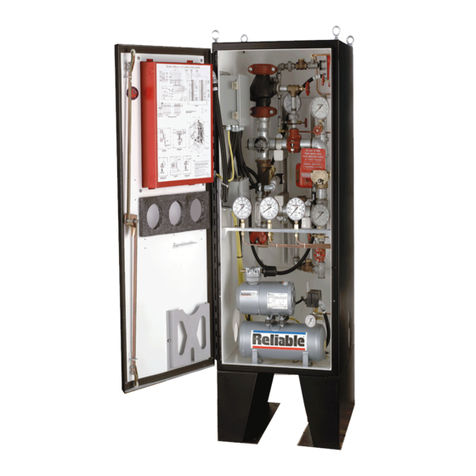
Reliable
Reliable H PrePak User guide
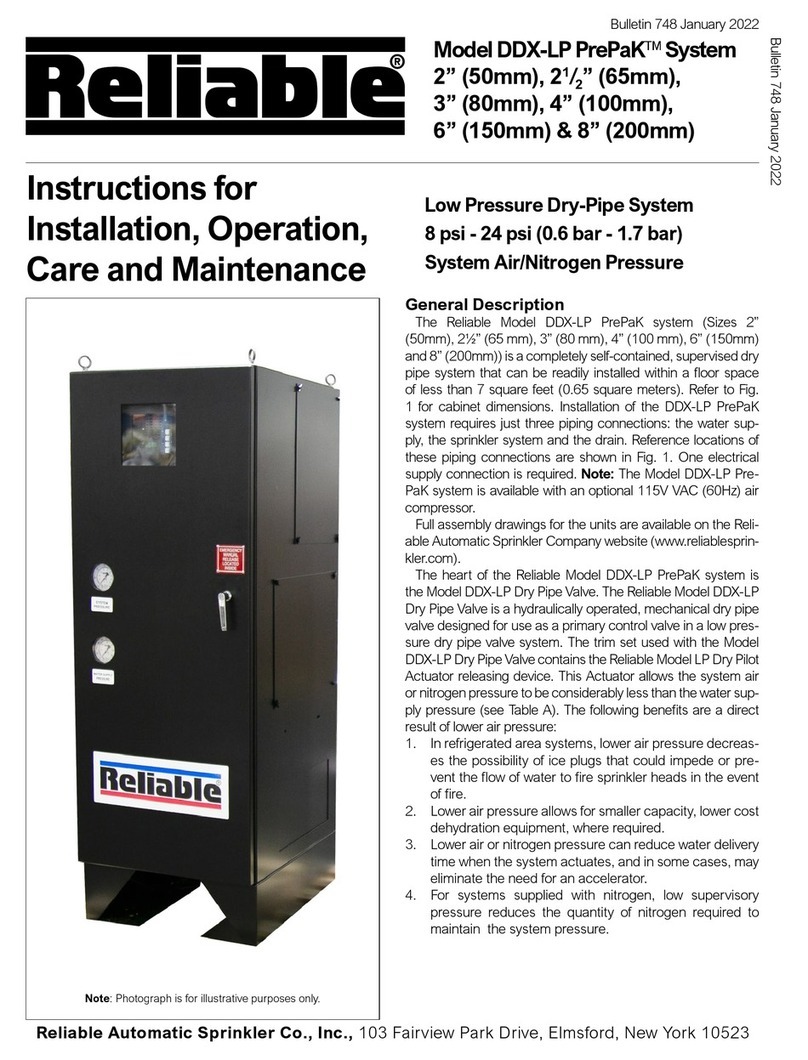
Reliable
Reliable DDX-LP PrePak Maintenance manual
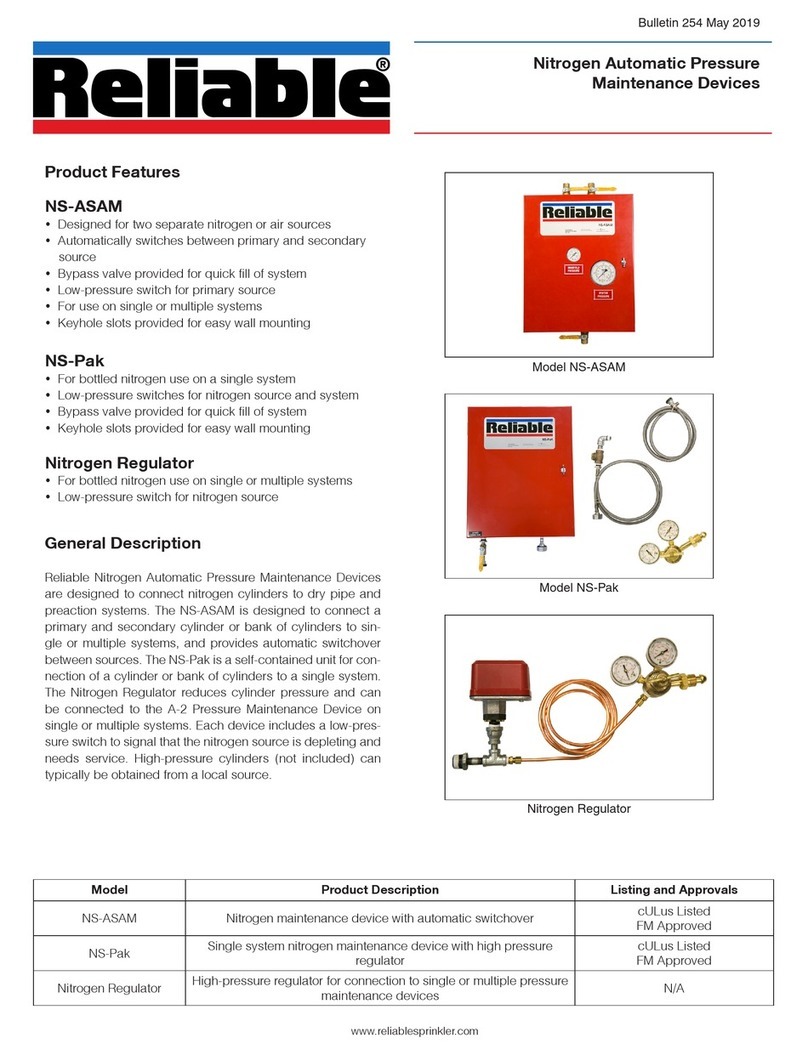
Reliable
Reliable NS-ASAM Manual

Reliable
Reliable 500PS User manual
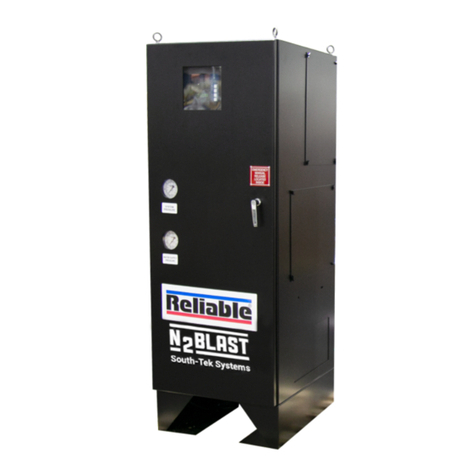
Reliable
Reliable N2-Blast DDX Maintenance manual
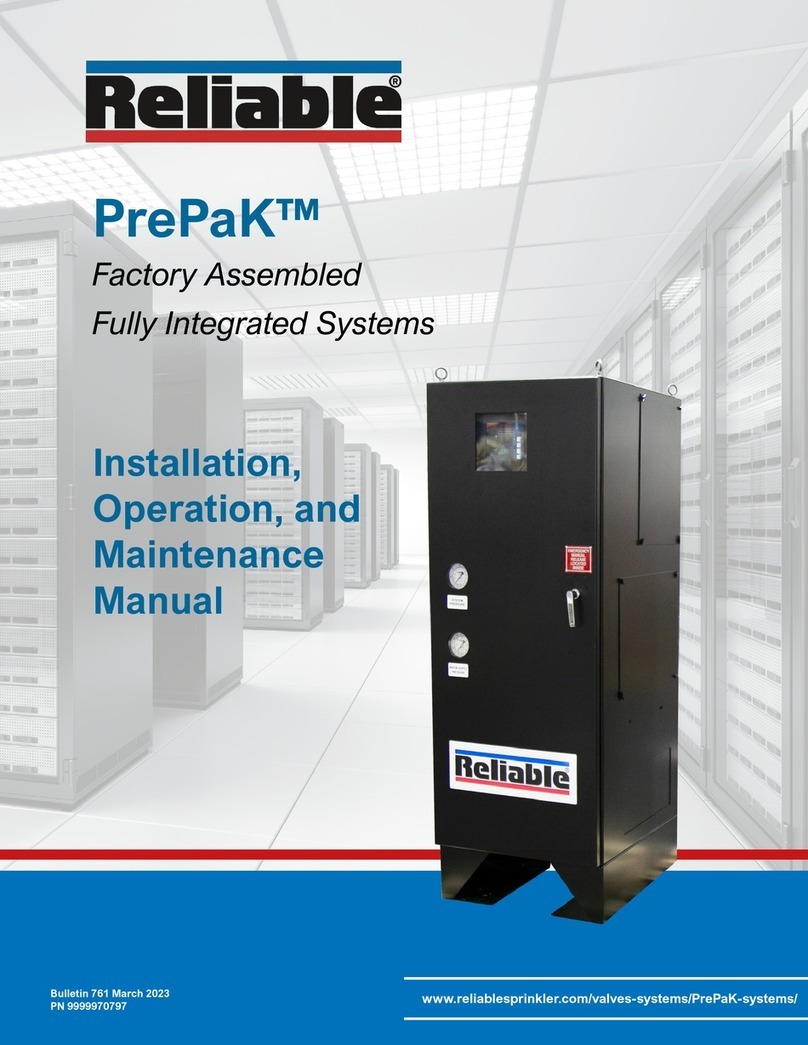
Reliable
Reliable DDX PrePaK User manual
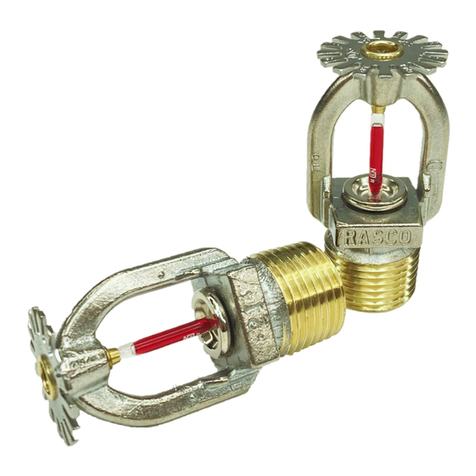
Reliable
Reliable F1FR56 User manual
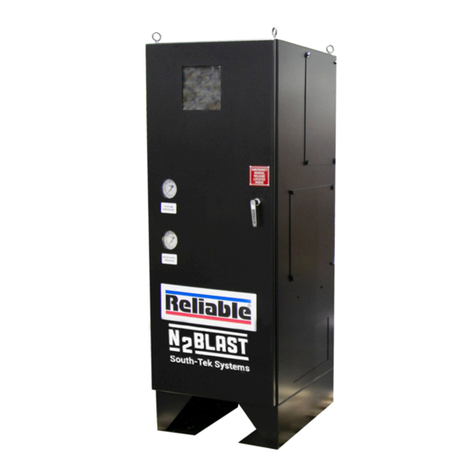
Reliable
Reliable N2-Blast DDX-LP PrePaK Maintenance manual
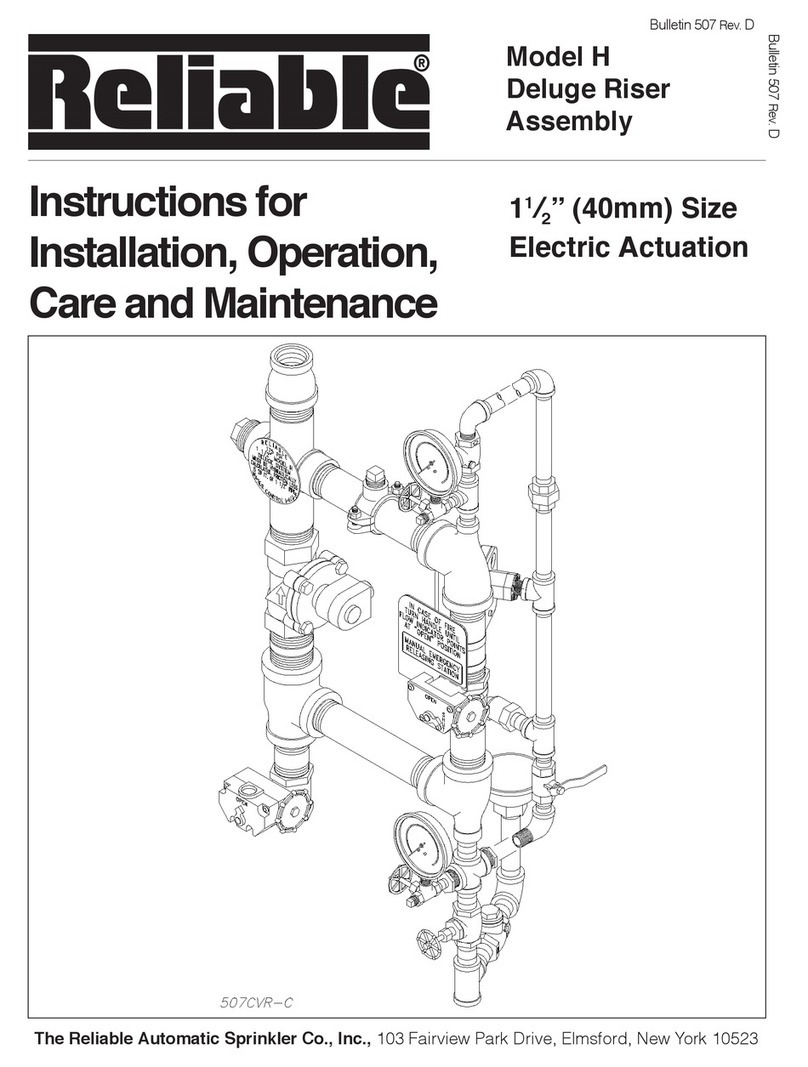
Reliable
Reliable H Deluge Riser Maintenance manual
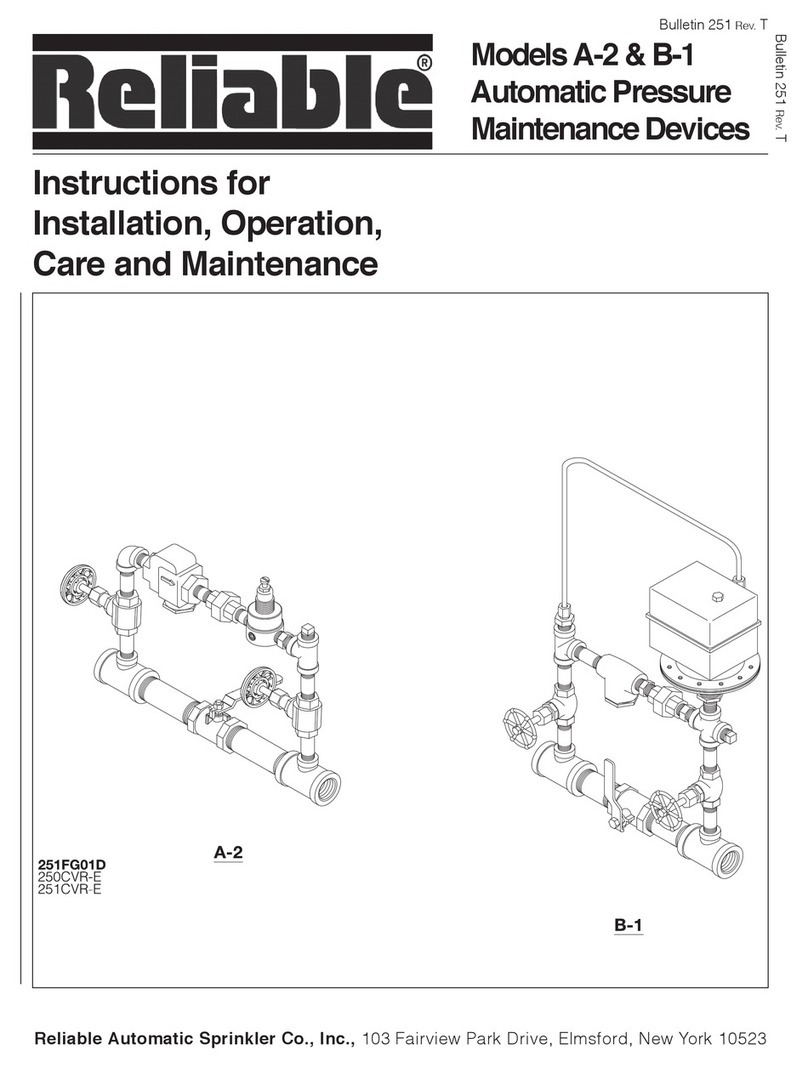
Reliable
Reliable A-2 Maintenance manual
